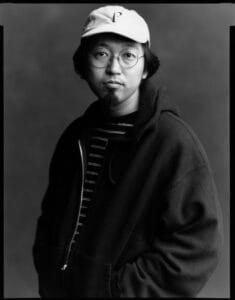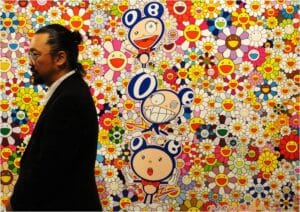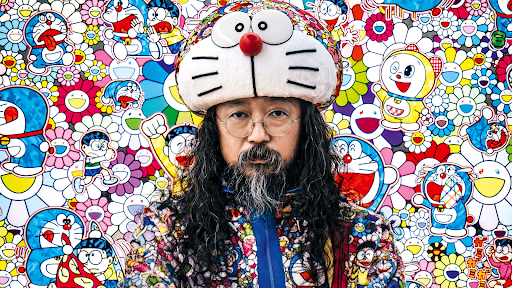No products in the cart.
The History of Takashi Murakami: A Journey Through Art and Culture
The History of Takashi Murakami: A Journey Through Art and Culture
Takashi Murakami is one of Japan’s most influential contemporary artists. His work is known for its bold colors, cartoon-like characters, and blend of high and low art. From galleries and museums to pop culture collaborations, Murakami has become a global sensation. However, behind his vibrant and playful creations lies a deeper message about society, culture, and the changing world of art.
This blog will explore the history of Takashi Murakami, from his early life and influences to his rise in the art world and lasting impact on both Japanese and global culture.
Early Life and Education
Takashi Murakami was born on February 1, 1962, in Tokyo, Japan. As a child, he was fascinated by anime and manga, popular forms of entertainment in Japan. This early exposure to these art forms would later shape much of his work. Unlike many traditional Japanese artists, Murakami did not grow up with an interest in classical Japanese art. Instead, he was drawn to the world of animation, video games, and comic books.
Murakami’s formal art education began when he enrolled at the Tokyo University of the Arts. Initially, he studied traditional Japanese painting, known as Nihonga. Nihonga is an art style that focuses on creating paintings using techniques and materials that date back to Japan’s Edo period. Although Murakami excelled in this traditional form, he eventually grew bored with it. He found the strict rules of Nihonga limiting and wanted to explore new ideas and forms of expression.
It was during his time at university that Murakami began to develop his signature style, combining traditional Japanese art with modern pop culture. He earned both his bachelor’s and master’s degrees in fine arts from Tokyo University of the Arts. After completing his studies, he continued his education by earning a Ph.D. in Nihonga. However, his discontent with the traditional art world would push him in a different direction.

Superflat and the Rise of a New Art Movement
In the late 1990s, Takashi Murakami introduced a concept that would define much of his career: Superflat. Superflat is a term Murakami coined to describe both a style of art and a cultural commentary. The term refers to the flatness of traditional Japanese art, such as woodblock prints, as well as the lack of distinction between high and low culture in Japan. For Murakami, Superflat was more than an aesthetic; it was a way of looking at how Japanese society and culture had become “flattened” by consumerism and the blending of art forms.
Superflat art often combines the visual language of anime and manga with fine art techniques. Takashi Murakami’s works are full of playful, colorful characters that at first glance seem lighthearted and fun. However, a closer look often reveals deeper, more complex themes related to society, politics, and even Japan’s relationship with the West.
One of Murakami’s most famous early works is “Mr. DOB”, a character that became a sort of alter-ego for the artist. Mr. DOB is a cartoon-like figure with large, round ears and a mischievous smile. At first, the character seems cute and harmless, but it also represents the blending of cultures, capitalism, and the influence of Western brands on Japanese pop culture.
Collaborations and Global Success
In the early 2000s, Murakami’s art began to gain international recognition. His unique blend of pop culture, fine art, and social commentary caught the attention of galleries and collectors around the world. However, it was his collaboration with fashion house Louis Vuitton that truly cemented his place as a global icon.
In 2002, Murakami worked with Louis Vuitton’s creative director Marc Jacobs to create a line of handbags featuring his colorful designs. The collaboration was a massive success, with Murakami’s designs becoming highly sought after by fashion enthusiasts and art collectors alike. This partnership blurred the lines between art and fashion, making Takashi Murakami’s work accessible to a broader audience and bringing the world of high fashion into the realm of contemporary art.
Murakami’s collaborations didn’t stop with Louis Vuitton. Over the years, he has worked with many brands and celebrities, including Kanye West, for whom he created the album cover for “Graduation”, as well as Pharrell Williams, Drake, and Billie Eilish. These partnerships allowed Takashi Murakami to reach audiences beyond the traditional art world, further solidifying his influence on popular culture.
Kaikai Kiki and Nurturing the Next Generation of Artists
In addition to his own work, Murakami is dedicated to supporting and promoting young artists. In 2001, he founded Kaikai Kiki Co., Ltd., an art production and management company that helps emerging artists gain exposure and develop their careers. Kaikai Kiki is also responsible for organizing large-scale art exhibitions, such as GEISAI, a Japanese art fair that gives young artists a platform to showcase their work.
Through Kaikai Kiki, Takashi Murakami has mentored many artists who share his vision of blending high and low art, as well as those who are interested in exploring the complexities of modern society through their work. The company also produces merchandise, prints, and other products, allowing a wider audience to access Murakami’s art at more affordable prices.

The Meaning Behind the Art
While Murakami’s art is often bright, playful, and filled with cartoon-like characters, it is also deeply reflective of Japanese society and history. One recurring theme in his work is Japan’s relationship with its past, particularly the trauma of World War II and the country’s post-war transformation. Murakami has often explored the idea of Japan’s cultural identity being shaped by its interactions with the West, especially through the lens of consumerism and mass media.
Murakami’s work also comments on the way Japan consumes and exports its own culture. Characters like Mr. DOB, with their roots in anime and manga, represent the commercialization of Japanese culture both within Japan and abroad. Through Superflat, Murakami critiques the superficiality of modern society while celebrating the vibrancy and creativity of Japanese pop culture.
Legacy and Continued Influence
Takashi Murakami’s influence on the art world and pop culture is undeniable. He has successfully bridged the gap between fine art and commercial art, challenging the idea that the two must be separate. His ability to blend traditional Japanese aesthetics with modern-day pop culture has made him one of the most recognizable artists of his generation.
Murakami continues to create new works, exhibit in major galleries around the world, and collaborate with brands and artists across various industries. His legacy will likely be defined by his ability to push boundaries, challenge the status quo, and redefine what it means to be a contemporary artist.
Whether through his colorful Superflat works, his playful characters, or his collaborations with global brands, Murakami’s art speaks to the complexities of modern society while remaining accessible and fun. He has carved out a unique space in the art world, one that celebrates both tradition and innovation, and his work will continue to inspire future generations of artists and art lovers.










